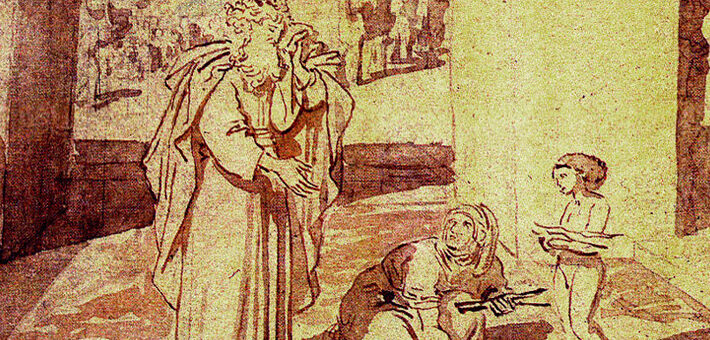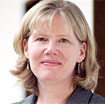Commentary on Luke 7:11-17
Hundreds of years before Jesus is born and embarks on a ministry of healing and preaching, Isaiah announces good news of God’s coming return to his people, Israel. At the time of God’s return and restoration of Israel the blind will see, the deaf will hear, and the lame will walk (Isaiah 35:4-6).
Jesus connects this picture of Isaianic restoration taken from Isaiah 35 with what is happening in his own ministry when he is asked if he is the “one who is to come” (7:19). Jesus replies, “the blind receive their sight, the lame walk, the lepers are cleansed, the deaf hear, the dead are raised, the poor have good news brought to them” (7:22).
Although the Isaiah text does not mentioned the dead being raised (yet see Isaiah 29:19), Luke includes resurrection as a sign of Jesus’ messianic activity as well. And Luke has just narrated a living example of this healing and resurrecting activity in 7:11-17, as Jesus raises a young man from the dead.
Jesus and his disciples, followed by a large crowd, come to Nain, a Galilean town not far from Nazareth. As they are about to enter, they encounter a funeral procession that is presumably on its way to a place of burial outside the city. Jesus approaches the body of a young man being carried on a bier, a structure that allowed for the transport of a body or coffin for burial. Jesus commands the young man to rise, and he does. With great reverence, the crowd praises God and exclaims that a great prophet has come among them, with news of what Jesus has done spreading far and wide.
What is missing from this brief rehearsal of the story is the recipient of this miraculous resuscitation, as Luke sees it. Jesus responds to the need of a widow, whose only son has died (7:12) and has compassion on her (7:13). Luke’s inclusion of the detail that this was her only son highlights her difficult situation. Without a husband and now without any son to support her, it is very likely that she is now or will soon be financially destitute. Luke’s shaping of the story suggests that her sole means of support has been taken from her.
For Luke emphasizes that, when Jesus sees her situation, “his heart went out to her” (7:13, niv). Three times Luke inserts the feminine pronoun into this single verse. Jesus’ compassion is fueled by the widow’s plight. In the ancient world much more than in contemporary Western settings, it was the case that people’s children were their retirement. Jesus’ compassionate restoration of this widow’s son may have meant the difference between survival and destitution.
Jesus’ compassion to heal has already been highlighted in the previous account of a centurion asking Jesus to heal his slave (7:1-10). His healing on behalf of a poor widow also fits the programmatic kingdom activity outlined in Luke 4:16-18 drawn from Isaiah 61. Jesus comes to “bring good news to the poor… and proclaim release to the captives” (4:18). In fact, Luke shows particular interest in including widows in his telling of Jesus’ story.
From the widow Anna who celebrates the arrival of Jesus (2:37) to the widow who gives her few pennies to the temple treasury (21:1-4), Luke narrates stories about widows more than any of the other three evangelists (see 4:25-26; 18:1-8; 20:46-47; also Acts 6:1; 9:36-42). As widows were one of the groups most needing community care according to Israel’s Scriptures (along with orphans and non-Israelites living in the land; see Deuteronomy 14:29), so Luke highlights both a widow’s need and Jesus’ compassionate response to her situation.
The conclusion to this healing story is important to Luke’s theological message. First, the crowds are filled with awe and praise God, saying, “God has come to help his people” (7:16; niv). Jesus’ healing actions point to God’s restoration now begun in Jesus. Luke frequently highlights responses of the crowds to Jesus’ healing activity.
For example, after Jesus heals a paralytic, the people are amazed and “they glorified God and were filled with awe” (5:26). When he heals a demon-possessed boy, “all were astounded at the greatness of God” (9:43). And when Jesus heals a women suffering from a crippling spirit, the crowd rejoices “at all the wonderful things that he was doing” (13:17).
The crowds also affirm, “A great prophet has risen among us!” (7:16). An important part of Luke’s Christology is his portrayal of Jesus as prophet. Jesus himself refers to his prophetic role more than once (Luke 4:24; 13:33), and the two disciples on the road to Emmaus affirm that Jesus was a “prophet mighty in word and deed” (24:19; see also 7:39). Luke “unmistakably identifies Jesus as the prophetic Messiah.”1
And as we highlight for the church today Luke’s portrait of Jesus as prophetic Messiah, center stage is Jesus’ care for the most vulnerable in society — here a widow without children and so without means of support. And as Luke systematically connects the church’s ministry to Jesus’ own mission, we have the evangelist’s mandate to exhort our churches to embrace compassionate ministry to the poor in Jesus’ name.
1L. T. Johnson, Prophetic Jesus, Prophetic Church,58.


June 9, 2013